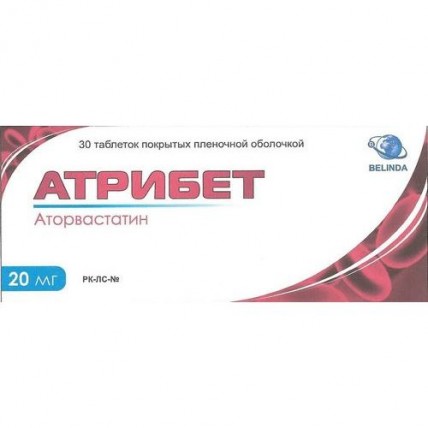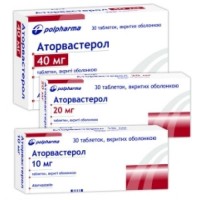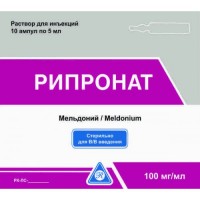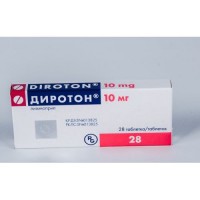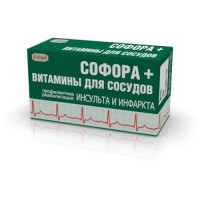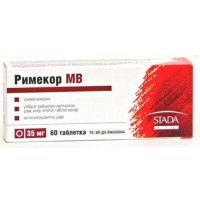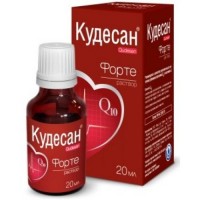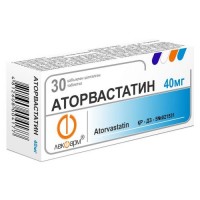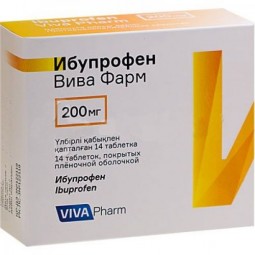Atribet 30s 20 mg film-coated tablets
- $25.80
The instruction for medical use of medicine atribt Trade nazvaniyeatribt the International unlicensed name Atorvastatin Lekarstvennaya the Tablet form, film coated 10 mg, 20 mg, 40 mg and 80 mg Structure One tablet contains active agent – an atorvastatin of calcium of trihydrate of 10.85 mg, 21.70 mg, 43.38 mg, 86.80 mg in terms of atorvastatin 10 mg, 20 mg, 40 mg, 80 mg excipients: Kernel: calcium carbonate, powder, lactoses monohydrate, cellulose microcrystalline, sodium of a kroskarmelloz, povidone, sorbitan polyoxyethylene ethers of fatty acids (Polisorbat 60), silicon dioxide colloidal anhydrous, talc, magnesium stearate, Cover: Opadri white 03F28342. The description of the Tablet, film coated white color, round shape, with a biconvex surface (for dosages of 10 mg and 20 mg). Tablets, film coated white color, round shape, with a biconvex surface, with risky on one party (for dosages of 40 mg and 80 mg). On a break it is visible a kernel of almost white color and a thin film cover of white color. Pharmacotherapeutic group Hypolipidemic drugs. Gipokholesterinemichesky and gipotriglitseridemichseky drugs. Reductase HMG CoA inhibitors. Atorvastatin. ATX C10AA05 code Pharmacological Pharmacokinetics Absorption properties. After intake atorvastatin it is quickly soaked up in blood. The maximum concentration (Cmax) in blood plasma is reached within 1-2 hours. Extent of absorption increases in proportion to a dose of an atorvastatin. Meal reduces the speed and duration of absorption of drug a little (by 25% and 9% respectively), however, decrease in cholesterol is similar to that at reception of an atorvastatin without food. The absolute bioavailability of an atorvastatin is about 12%, the system bioavailability defining the inhibiting activity concerning GMG-KoA-reduktazy – 30%. The low system bioavailability is caused by presistemny metabolism in mucous digestive tract and at the first passing through a liver. Distribution. The average volume of distribution of an atorvastatin is about 381 l. Communication with proteins of blood plasma – 98%. Metabolism. Atorvastatin is metabolized mainly in a liver with participation of isoenzymes of CYP3A4, CYP3A5 and CYP3A7 of P450 cytochrome with formation pharmacological of active metabolites (orto- and parahydroxylated derivatives, beta oxidation products). In vitro orto- and parahydroxylated metabolites have inhibiting effect on GMG-KoA-reduktazu, comparable to that at an atorvastatin. The inhibiting effect of drug concerning GMG-KoA-reduktazy about 70% is defined by activity of the circulating metabolites. Removal. Atorvastatin is brought mainly with bile after hepatic and/or extrahepatic metabolism (is not exposed to the significant enterohepatic recirculation). Elimination half-life – 14 hours. The inhibiting activity concerning GMG-KoA-reduktazy remains about 20-30 hours thanks to existence of active metabolites. Less than 2% of the dose of drug accepted inside are defined in urine. It is not removed during a hemodialysis. Special groups of patients Elderly: concentration of an atorvastatin in blood plasma at aged people of 65 years are also more senior above (Cmax approximately for 40%, AUC approximately for 30%), than at adult patients of young age, differences in safety, efficiency or achievement of the goals of hypolipidemic therapy at elderly people in comparison with the general population it is not revealed. Children: drug pharmacokinetics researches at children were not conducted. Floor: concentration of an atorvastatin in blood plasma at women differs (Cmax is about 20% higher, and AUC 10% lower) from that at men, however clinically significant distinctions of influence of drug on lipidic exchange at men and women are not revealed. Renal failure: the disease of kidneys does not affect concentration of an atorvastatin in blood plasma or its impact on indicators of lipidic exchange, in this regard change of a dose with a renal failure does not require from patients. Hemodialysis: it is improbable that the hemodialysis will lead to significant increase in clearance of an atorvastatin as drug is substantially connected with proteins of blood plasma. Liver failure: concentration of an atorvastatin considerably increases (Cmax approximately on 16 times, AUC approximately by 11 times) at patients with alcoholic cirrhosis (Chayld-Pyyu C). The pharmacodynamics Atorvastatin is a selection competitive inhibitor of GMG-KoA-reduktazy – the enzyme determining the speed limit of biosynthesis of the cholesterol responsible for transformation of 3-hydroxy-2-methyl-glyutaril-coenzyme A in mevalonat, the predecessor of sterols including cholesterol. In a liver triglycerides and cholesterol is included lipoproteins of very low density (LPONP), come to blood plasma and are transported to peripheral fabrics. Lipoproteins of the low density (LDL) which catabolize mainly by means of interaction with high-affine receptors of LDL are formed of LPONP. Atorvastatin reduces levels of cholesterol and lipoproteins in blood plasma at the expense of inhibition of GMG-KoA-reduktazy and synthesis of cholesterol in a liver and also due to increase in number of hepatic receptors of the LDL at surfaces of cells increasing LDL. Drug reduces products of LDL and quantity of particles of LDL. Atorvastatin causes the significant and permanent increase in activity of receptors of LDL in combination with favorable changes of quality of the circulating LDL particles. Dozozavisimo reduces the LDL level at patients with the homozygous hereditary hypercholesterolemia resistant to therapy with other lipidemichesky means. Ratio researches dose/effect showed that atorvastatin reduces the level of the general cholesterol (by 30-46%), LDL cholesterol (for 41-61%), apolipoprotein B (for 34-50%) and triglycerides (for 14-33%), at the same time causing, to a degree, increase of levels of cholesterol in LPVP and apolipoprotein A. These results were similar at patients with a heterozygous family hypercholesterolemia, single forms of a hypercholesterolemia and the mixed lipidemia, including patients with non-insulin-dependent diabetes mellitus. Due to the decrease in level of the general cholesterol, LDL cholesterol and apolipoprotein the risk of progressing of cardiovascular diseases goes down and, respectively, the risk of death decreases. Researches of influence of an atorvastatin of 80 mg on dynamics of a condition of patients with a sharp coronary syndrome in a sharp phase after hospitalization and proceeding within 16 weeks confirmed decrease in such risk by 16%. When using drug at elderly patients of differences in safety, efficiency or achievement of the goals of hypolipidemic therapy in comparison with the general population it was not noted. Indications Hypercholesterolemia: - as addition to a diet for decrease in the increased general level of cholesterol, cholesterol lipoproteins of the low density (LDL), apolipoprotein B and triglycerides at adults, teenagers and children is aged more senior than 10 years with primary hypercholesterolemia, including a family hypercholesterolemia (heterozygous option) or the combined (mixed) lipidemia (the IIa and IIb type to Fredrikson) when there is an insufficient answer to a diet and other not pharmacological methods of treatment. - for decrease in the general cholesterol and cholesterol - lipoproteins of the low density (LDL) at adults with a homozygous family hypercholesterolemia, as addition to other hypolipidemic types of treatment (for example, aferez LDL) or if such methods of treatment are inaccessible. Prevention of cardiovascular diseases: - for prevention of cardiovascular diseases at adult patients, having high risk of primary cardiovascular disease, as addition and for correction of other risk factors. The route of administration and doses the Drug Atribet is intended for oral administration. A daily dose it is necessary to accept all at once, at any time with food or without it. Before an initiation of treatment atorvastatiny it is necessary to try to achieve control of a hypercholesterolemia by means of a diet, physical exercises and decrease in body weight from patients with obesity and also treatment of a basic disease. When prescribing drug the patient needs to recommend a standard gipokholesterinemichesky diet which he has to observe during treatment. The initial dose makes 10 mg once a day. Doses have to be regulated individually depending on the LDL level, the purpose of therapy and reaction of the patient to treatment. The drug can be taken at any time once a day irrespective of meal. At the beginning and/or during increase in a dose of Atribet it is necessary to control each 2-4 weeks levels of lipids in blood plasma and as appropriate to korrigirovat a dose. It is necessary to carry out dose adjustment with intervals not less than 4 weeks. The maximum daily dose makes 80 mg. Primary hypercholesterolemia and the combined (mixed) lipidemia. At most of patients the necessary control of levels of lipids is provided with reception of 10 mg of Atribet once a day. The essential therapeutic effect is observed usually in 4 weeks. At long-term treatment this effect remains. Heterozygous family hypercholesterolemia. Treatment of patients it is necessary to begin with appointment 10 mg of Atribet a day. Carrying out individual dose adjustment each 4 weeks, it is necessary to bring it to 40 mg/day. After that it is possible to increase a dose to the maximum level equal to 80 mg/day, or to apply the combined purpose of 40 mg of Atribet and the sekvestrant of bile acids. Homozygous family hypercholesterolemia. There are limited data on drug use the given disease. The dose of an atorvastatin at patients with a homozygous family hypercholesterolemia makes from 10 to 80 mg of 1 times a day. Atribet needs to apply as addition to other methods of decrease in lipids (for example, LDL an afereza) or if these methods of treatment are inaccessible. Prevention of cardiovascular diseases In researches on primary prevention, a dose made 10 mg/days. For achievement of the recommended cholesterol level (according to the acting national leaders), higher doses of the drug Atribet can be necessary. Patients with a renal failure. Diseases of kidneys do not affect concentration of an atorvastatin in blood plasma or extent of decrease in lipids at drug Atribet use, in this regard, with diseases of kidneys is not required to any dose adjustment from patients. Patients with an abnormal liver function At patients with moderate and heavy hepatic dysfunction, action of an atorvastatin did not change, but drug influence considerably increases. Cmax increases approximately by 16 times, and AUC (0-24) approximately by 11 times. Therefore it is necessary to show care at patients who use a significant amount of alcohol and/or have in the anamnesis of a disease of a liver. The drug Atribet is contraindicated to patients with an active disease of a liver. Patients of advanced age Efficiency and safety of the recommended doses at patients are more senior 70 are similar to those which are applied in the general population. Children Hypercholesterolemia: Experience of use of drug for children is limited and insufficient. Lipidemias can appoint drug to children at treatment only experienced doctors, patients have to look round regularly for assessment of dynamics of process. For patients at the age of 10 years is also more senior, the recommended initial dose of Atribet makes 10 mg a day with increase to 20 mg a day. Increase in a dose should be carried out according to individual reaction and shipping of sick children. Information on safety of doses is higher than 20 mg at children that corresponds to about 0.5 mg/kg, is limited. Drug should not is used at children 10 years are younger. The passed dose. It is impossible to accept a double dose for the purpose of compensation of the passed medicine dose, it is necessary to continue the recommended dosed intake of medicine and to accept the following dose at the scheduled time. Side effects Often (1%) - a headache - a hyperglycemia, increase in activity of serumal KFK, rejection of functional hepatic tests - a nasopharyngitis, throat, throat pain, nasal bleeding - allergic reactions - a constipation, a meteorism, dyspepsia, nausea, diarrhea - myalgia, an arthralgia, extremity pain, muscular spasms, swelling of joints, dorsodynias. Seldom: - thrombocytopenia - a peripheral neuropathy - disorders of vision - cholestatic jaundice - a Quincke's disease, bullous rash, a polymorphic exudative erythema (including Stephens-Johnson's syndrome), a Lyell's disease - a miositis, a myopathy, rabdomilioz, the tendopatiya which sometimes is complicated by a rupture of sinews. Very seldom: - an anaphylaxis - a hearing loss - a liver failure - a gynecomastia. Infrequently: - a hypoglycemia, increase in body weight, anorexia - dreadful dreams, insomnia - dizziness, paresthesias, a hypesthesia, a dysgeusia, amnesia. - indistinct sight - sonitus - vomiting, an abdominal pain upper and lower, an eructation, pancreatitis, hepatitis - urticaria, skin rash, an itching, an alopecia - neck pain, fatigue of muscles - an indisposition, an asthenia, a stethalgia, peripheral hypostases, fatigue, a hyperthermia - positive test for leukocytes in urine. It is not known: - immunomediated a necrotic myopathy. As well as in case of other inhibitors of GMG-KoA-reduktazy, the raised indicators of transaminases in blood serum were noted at the patients receiving atorvastatin. These changes, as a rule, the easy, passing and not demanding treatment interruptions. Clinically important increase in serum of transaminases (& gt, 3 times from the upper bound of norm) was noted at 0.8% of the patients receiving atorvastatin. This increase is connected with a dose and was reversible at all patients. In clinical trials, the increased creatine kinase levels in blood serum (more, than is 3 times higher than the upper bound of norm) were noted at 2.5% of the patients accepting atorvastatin, similar changes were noted also at use of other inhibitors of GMG-KoA-reduktazy. The levels by 10 times exceeding the upper bound of norm were noted at 0.4% of the patients receiving treatment atorvastatiny. Children Often: - headache, abdominal pain, increase in alaninaminotranspherase, creatine of blood, phosphokinase. On the basis of the available data, children, as expected, will have a frequency, type and weight of side reactions the same, as well as at adults. Now there is a limited experience in the relation of long-term safety of use of drug for children. The next adverse events were registered with some statines: - sexual dysfunction - a depression - exceptional cases of an interstitial disease of lungs, especially at long-term treatment - diabetes (frequency will depend on existence or lack of risk factors in the form of level in blood on an empty stomach ≥ glucose of 5.6 mmol/l, ИМТ>, 30 kg/sq.m, increases in triglycerides, the available hypertension). Contraindications - hypersensitivity to drug components - active diseases of a liver or increase in activity of liver enzymes of not clear genesis (is more than 3 times higher than the upper bound of norm) - pregnancy and the period of a lactation, the women of reproductive age who are not using effective measures of contraception - children's age up to 10 years (the efficiency and safety are not established) - a hereditary lactose intolerance, deficiency of enzyme of LAPP lactase, glucose galactose malabsorption. With care: - to the patients abusing alcohol - in liver diseases in the anamnesis - heavy disturbances of electrolytic balance - endocrine and metabolic disturbances - arterial hypotension - a heavy acute infection (sepsis) - uncontrollable epilepsy - extensive surgical interventions - injuries, diseases of skeletal muscles Medicinal interactions Influence of in common administered medicines on atorvastatin Atorvastatin is metabolized tsitokhromomy P450 3A4 (CYP3A4) and is substrate for transport proteins of hepatic absorption, the OATP1B1 conveyor. Simultaneous use of medicines which are CYP3A4 inhibitors or transport proteins can lead to increase in concentration of an atorvastatin in blood plasma and to the increased risk of development of a myopathy. The risk can be also increased at simultaneous
use of an atorvastatin with other medicines which can cause a myopathy, such as derivative of fibroyevy acid and ezetimib (watch Section 4.4). CYP3A4 inhibitors Strong CYP3A4 inhibitors as it was shown, lead to noticeable increase in concentration of an atorvastatin (see table 1 and detailed information given below). Joint administration of strong CYP3A4 inhibitors (for example, cyclosporine, telitromitsin, klaritromitsin, delavirdin, stiripentol, ketokonazol, vorikonazol, itrakonazol, pozakonazol and HIV inhibitors - protease, including ritonavir, lopinavir, atazanavir, indinavir, darunavir, etc.) if it is possible, should be avoided them. When combined use of these medicines with atorvastatiny cannot be avoided, it is necessary to consider purpose of lower initial and maximum dose of an atorvastatin and appropriate clinical monitoring of the patient is recommended (cm table 1). Moderate CYP3A4 inhibitors (for example, erythromycin, diltiazem, verapamil and flukonazol) can increase plasma concentration of an atorvastatin (table 1). The increased risk of a myopathy is observed at use of erythromycin in a combination with statines. Interaction researches for assessment of the impact of Amiodaronum or verapamil on atorvastatin were not conducted. Both Amiodaronum and verapamil, as we know, oppress activity of CYP3A4 and combined use with atorvastatiny can lead to increase in influence of an atorvastatin. Thus, at simultaneous use with moderate CYP3A4 inhibitors it is necessary to consider lower maximum dose of an atorvastatin, carrying out appropriate clinical monitoring of the patient is recommended. The corresponding clinical monitoring is recommended after the beginning or after correction of a dose of inhibitor. Simultaneous use of an atorvastatin with inductors of P450 3A cytochrome (for example, efavirenz, rifampicin, a St. John's wort) can lead the inductors CYP3A4 to decrease in plasma concentration of an atorvastatin. Because of the double mechanism of interaction of rifampicin, (by means of induction of P450 3A cytochrome and inhibition of absorption the hepatocytes of the carrier of OATP1B1), recommend simultaneous regulation at combined use of an atorvastatin with rifampicin as the delay of reception of an atorvastatin after administration of rifampicin was connected with considerable decrease in concentration of an atorvastatin in blood plasma. The effect of rifampicin on concentration of an atorvastatin in hepatocytes, however, is unknown, and if co-administration cannot be avoided, patients have to be observed carefully regarding efficiency of treatment. Inhibitors of transport proteins Inhibitors of transport proteins (for example, cyclosporine) can strengthen system influence of an atorvastatin (see table 1). Influence of oppression of hepatic absorption of conveyors on concentration of an atorvastatin in hepatocytes is not known. If the accompanying appointment cannot be avoided, the dose decline and clinical monitoring of efficiency is recommended (see table 1). Derivative gemifibrozil / derivatives of fibrinous acid Use in monotherapy of fibrat sometimes is associated with muscular disorders, including a rhabdomyolysis. Risk of development of these events can be increased at simultaneous use of an atorvastatin and derivatives of fibrinous acid. If co-administration cannot be avoided, the lowest dose of an atorvastatin has to be applied to achievement of the medical purpose, and patients have to be controlled properly (see Section 4.4). Ezetimib Use only of an ezetimib, is connected with the events connected with muscles including a rhabdomyolysis. Therefore, the risk of these events can be increased at simultaneous use of an ezetimib and atorvastatin. In such cases the corresponding clinical monitoring of patients is recommended. Kolestipol Koncentratsii in plasma of an atorvastatin and his active metabolites were lower (approximately for 25%) when kolestipol it was applied together with atorvastatiny. However lipidic effects were more expressed when atorvastatin and kolestipol were accepted in common, than at monotherapy. Fusidic acid Risk of a myopathy, including a rhabdomyolysis can be raised due to simultaneous system use of fusidic acid and statines. The mechanism of these interactions (pharmakodinamichesky, pharmacokinetic or both), is unknown so far. Messages about a rhabdomyolysis (even with a fatal outcome) at the patients receiving this combination arrived. If system administration of fusidic acid is necessary, treatment atorvastatiny should be stopped for the entire period of treatment by fusidic acid (see Section 4.4). Influence of an atorvastatin on in common administered medicines Digoxin At joint introduction of several doses of digoxin and 10 mg of an atorvastatin, equilibrium concentration of digoxin increased slightly. The patients accepting digoxin have to be controlled properly. Oral contraceptives Joint reception of an atorvastatin with an oral contraceptive causes increase in plasma concentration of norethindrone and ethinylestradiol, oestradiol. Warfarin In clinical trial at patients, it is long receiving warfarin, joint introduction of a daily dose of warfarin from atorvastatiny 80 mg caused small decrease to 1.7 seconds of a prothrombin time during the first 4 days of reception of a dose which then within 15 days of treatment atorvastatiny, returned to normal values. Though very exceptional cases of clinically significant interactions with anticoagulants, before reception of an atorvastatin were celebrated, at the patients accepting anticoagulant coumarin the prothrombin time has to be defined, and further it needs to be done rather often during the initial stage of therapy to have a warranty that no significant change of a prothrombin time is observed. After documentary confirmed stabilization of a prothrombin time, it can be controlled with the frequency which is usually recommended for the patients receiving anticoagulant coumarin. If the dose of an atorvastatin changes or treatment stops, this procedure has to be carried out repeatedly. Treatment atorvastatiny did not cause bleedings or changes of a prothrombin time in the patients who are not accepting anticoagulants. Table 1. Influence of in common administered medicines on pharmacokinetics of an atorvastatin At the same time appointed medication, its dose Atorvastatin Doza (mg) Change of AUC& the Clinical recommendation Tipranavir 500 mg two times / ritonavir 200 mg two times, 8 days (days with 14 on 21) 40 mg in the 1st day, 10 mg for the 20th day ↑ 9.4 increase in indicators When simultaneous with atorvastatiny use is necessary, it is not necessary to exceed a daily dose of an atorvastatin of 10 mg. Clinical observation of these patients Telaprevir of 750 mg each 8 hours, 10 days of 20 mg a single dose ↑ 7.9 increase in indicators Cyclosporine of 5.2 mg/kg/day, a constant dose of 10 mg a day within 28 days ↑ 8 is recommended.7 increase in indicators Lopinavir of 400 mg a day / ritonavir 100 mg two times within 14 days of 20 mg a day within 4 days ↑ 5.9 increase in indicators In cases when joint reception with atorvastatiny is necessary, are recommended purpose of lower doses of an atorvastatin. At the doses of an atorvastatin exceeding 20 mg the clinical monitoring of these patients is recommended. Klaritromitsin of 500 mg two times, 9 days of 80 mg a day within 8 days ↑ 4.4 increase in indicators Sakvinavir of 400 mg twice a day / ritonavir (300 mg twice a day in 5-7dn to increase to 400 mg twice a day by 8 – oh day), 4-18 days. To accept in 30 min. after reception of an atorvastatin 40 mg a day within 4 days ↑ 3.9 increase in indicators When joint appointment with atorvastatiny is necessary, lower doses of an atorvastatin are recommended. At the doses of an atorvastatin exceeding 40 mg the clinical monitoring of these patients is recommended. Darunavir of 300 mg twice a day / ritonavir 100 mg twice a day, 9 days of 10 mg a day within 4 days ↑ 3.3 increase in indicators Itrakonazol of 200 mg once, 4 days of 40 mg a single dose ↑ 3.3 increase in indicators Fosamprenavir of 700 mg two times in / ritonavir 100 mg two times in 14 days, 10 mg a day within 4 days ↑ 2.5 increase in indicators Fosamprenavir of 1400 mg two times, 14 days of 10 mg a day within 4 days ↑ 2.3 increase in indicators Nelfinavir of 1250 mg two times, 14 days of 10 mg a day within 28 days ↑ 1.7 increase in indicators Are not present special recommendations Grapefruit juice, 240 ml of 40 mg a single dose ↑ 37% the Simultaneous use of large numbers of grapefruit juice once a day and the atorvastatina is not recommended. Diltiazem of 240 mg once a day, 28 days of 40 mg a single dose ↑ 51% After the beginning of reception or correction of a dose of diltiazem, is recommended appropriate clinical monitoring of these patients. Erythromycin of 500 mg four times a day, 7 days of 10 mg a single dose ↑ 33%^ Is recommended the maximum dose and clinical monitoring of these patients. Amlodipin of 10 mg, a single dose of 80 mg a single dose ↑ 18% there Are no special recommendations Cimetidinum of 300 mg four times a day, 2 weeks of 10 mg a day within 2 weeks ↓ less than 1%^ there Are no special recommendations Antacids (magnesian and aluminum hydroxides in suspension), on 30 ml four times a day, 2 weeks of 10 mg a day within 4 weeks ↓ 35%^ Are not present special recommendations Efavirents of 600 mg of OD, 14 days of 10 mg a day within 3 days ↓ 41% there Are no special recommendations Rifampicin of 600 mg once a day, 7 days (joint introduction) of 40 mg a single dose ↑ 30% If not to avoid simultaneous use, combined use of an atorvastatin with rifampicin demands due clinical monitoring. Rifampicin of 600 mg once a day, 5 days (in the divided dose) 40 mg a single dose ↓ 80% Gemfibrozil of 600 mg two times, 7 days of 40 mg a single dose ↑ 35% Is recommended the smallest initial dose and clinical monitoring of these patients. Fenofibrat of 160 mg once a day, 7 days of 40 mg a single dose ↑ 3% Is recommended the smallest initial dose and clinical monitoring of these patients. Botseprevir of 800 mg three times a day, 7 days of 40 mg a single dose ↑ 2.3 increase in indicators Is recommended the smallest initial dose and clinical monitoring of these patients. The dose of an atorvastatin should not exceed a daily dose of 20 mg during joint reception with botsepreviry. The data provided to x-fold change represent a simple ratio between combined use and reception of an atorvastatin separately (i.e. it is multiple = without changes). The data provided in % changes represent % a difference concerning the atorvastatin accepted separately (i.e. 0% = without changes). * Contains one or more components which inhibit CYP3A4 and can increase concentration in blood plasma of medicines at CYP3A4. Consumption of one glass of 240 ml of grapefruit juice also leads to decrease in AUC by 20.4% for an active orto-of hydroxy of a metabolite. Large numbers of grapefruit juice (more than 1.2 l a day within 5 days) raise AUC of an atorvastatin by 2.5 times and AUC of an active metabolite of an atorvastatin. Table 2: Influence of an atorvastatin on pharmacokinetics of in common entered Atorvastatin medicines and the dosing mode In common used medicine the Medicine / dose (mg) Change of AUC * the Clinical recommendations of 80 mg once a day within 10 days Digoxin of 0.25 mg once a day, 20 days ↑ 15% the Patients accepting digoxin have to be under appropriate control. There Are no 40 mg within 22 days the Oral contraceptive once a day, 2 months once a day - norethindrone of 1 mg - ethinylestradiol of 35 mkg ↑ 28% ↑ 19% the special recommendations of 80 mg within 15 days of Phenazone once a day, 600 mg, a single dose ↑ 3% there Are no special recommendations of 10 mg a single dose Tipranavir 500 mg two times / ritonavir 200 mg two times, there Are no 7 days changes there Are no special recommendations of 10 mg within 4 days Fosamprenavir 1400 mg two times, 14 days ↓ 27% once a day there Are no special recommendations of 10 mg within 4 days Fosamprenavir 700 mg two times / ritonavir 100 mg two times once a day, there Are no 14 days changes there Are no special recommendations * Basic data as % change, represent % a difference relatively only of one taken medicine (i.e. 0% = without changes) Increase is designated as '↑', decrease as '↓' Special instructions before therapy by the drug Atribet it is necessary to try to achieve control of a hypercholesterolemia by an adequate dietotherapy, increase in physical activity,
to Develop
use of an atorvastatin with other medicines which can cause a myopathy, such as derivative of fibroyevy acid and ezetimib (watch Section 4.4). CYP3A4 inhibitors Strong CYP3A4 inhibitors as it was shown, lead to noticeable increase in concentration of an atorvastatin (see table 1 and detailed information given below). Joint administration of strong CYP3A4 inhibitors (for example, cyclosporine, telitromitsin, klaritromitsin, delavirdin, stiripentol, ketokonazol, vorikonazol, itrakonazol, pozakonazol and HIV inhibitors - protease, including ritonavir, lopinavir, atazanavir, indinavir, darunavir, etc.) if it is possible, should be avoided them. When combined use of these medicines with atorvastatiny cannot be avoided, it is necessary to consider purpose of lower initial and maximum dose of an atorvastatin and appropriate clinical monitoring of the patient is recommended (cm table 1). Moderate CYP3A4 inhibitors (for example, erythromycin, diltiazem, verapamil and flukonazol) can increase plasma concentration of an atorvastatin (table 1). The increased risk of a myopathy is observed at use of erythromycin in a combination with statines. Interaction researches for assessment of the impact of Amiodaronum or verapamil on atorvastatin were not conducted. Both Amiodaronum and verapamil, as we know, oppress activity of CYP3A4 and combined use with atorvastatiny can lead to increase in influence of an atorvastatin. Thus, at simultaneous use with moderate CYP3A4 inhibitors it is necessary to consider lower maximum dose of an atorvastatin, carrying out appropriate clinical monitoring of the patient is recommended. The corresponding clinical monitoring is recommended after the beginning or after correction of a dose of inhibitor. Simultaneous use of an atorvastatin with inductors of P450 3A cytochrome (for example, efavirenz, rifampicin, a St. John's wort) can lead the inductors CYP3A4 to decrease in plasma concentration of an atorvastatin. Because of the double mechanism of interaction of rifampicin, (by means of induction of P450 3A cytochrome and inhibition of absorption the hepatocytes of the carrier of OATP1B1), recommend simultaneous regulation at combined use of an atorvastatin with rifampicin as the delay of reception of an atorvastatin after administration of rifampicin was connected with considerable decrease in concentration of an atorvastatin in blood plasma. The effect of rifampicin on concentration of an atorvastatin in hepatocytes, however, is unknown, and if co-administration cannot be avoided, patients have to be observed carefully regarding efficiency of treatment. Inhibitors of transport proteins Inhibitors of transport proteins (for example, cyclosporine) can strengthen system influence of an atorvastatin (see table 1). Influence of oppression of hepatic absorption of conveyors on concentration of an atorvastatin in hepatocytes is not known. If the accompanying appointment cannot be avoided, the dose decline and clinical monitoring of efficiency is recommended (see table 1). Derivative gemifibrozil / derivatives of fibrinous acid Use in monotherapy of fibrat sometimes is associated with muscular disorders, including a rhabdomyolysis. Risk of development of these events can be increased at simultaneous use of an atorvastatin and derivatives of fibrinous acid. If co-administration cannot be avoided, the lowest dose of an atorvastatin has to be applied to achievement of the medical purpose, and patients have to be controlled properly (see Section 4.4). Ezetimib Use only of an ezetimib, is connected with the events connected with muscles including a rhabdomyolysis. Therefore, the risk of these events can be increased at simultaneous use of an ezetimib and atorvastatin. In such cases the corresponding clinical monitoring of patients is recommended. Kolestipol Koncentratsii in plasma of an atorvastatin and his active metabolites were lower (approximately for 25%) when kolestipol it was applied together with atorvastatiny. However lipidic effects were more expressed when atorvastatin and kolestipol were accepted in common, than at monotherapy. Fusidic acid Risk of a myopathy, including a rhabdomyolysis can be raised due to simultaneous system use of fusidic acid and statines. The mechanism of these interactions (pharmakodinamichesky, pharmacokinetic or both), is unknown so far. Messages about a rhabdomyolysis (even with a fatal outcome) at the patients receiving this combination arrived. If system administration of fusidic acid is necessary, treatment atorvastatiny should be stopped for the entire period of treatment by fusidic acid (see Section 4.4). Influence of an atorvastatin on in common administered medicines Digoxin At joint introduction of several doses of digoxin and 10 mg of an atorvastatin, equilibrium concentration of digoxin increased slightly. The patients accepting digoxin have to be controlled properly. Oral contraceptives Joint reception of an atorvastatin with an oral contraceptive causes increase in plasma concentration of norethindrone and ethinylestradiol, oestradiol. Warfarin In clinical trial at patients, it is long receiving warfarin, joint introduction of a daily dose of warfarin from atorvastatiny 80 mg caused small decrease to 1.7 seconds of a prothrombin time during the first 4 days of reception of a dose which then within 15 days of treatment atorvastatiny, returned to normal values. Though very exceptional cases of clinically significant interactions with anticoagulants, before reception of an atorvastatin were celebrated, at the patients accepting anticoagulant coumarin the prothrombin time has to be defined, and further it needs to be done rather often during the initial stage of therapy to have a warranty that no significant change of a prothrombin time is observed. After documentary confirmed stabilization of a prothrombin time, it can be controlled with the frequency which is usually recommended for the patients receiving anticoagulant coumarin. If the dose of an atorvastatin changes or treatment stops, this procedure has to be carried out repeatedly. Treatment atorvastatiny did not cause bleedings or changes of a prothrombin time in the patients who are not accepting anticoagulants. Table 1. Influence of in common administered medicines on pharmacokinetics of an atorvastatin At the same time appointed medication, its dose Atorvastatin Doza (mg) Change of AUC& the Clinical recommendation Tipranavir 500 mg two times / ritonavir 200 mg two times, 8 days (days with 14 on 21) 40 mg in the 1st day, 10 mg for the 20th day ↑ 9.4 increase in indicators When simultaneous with atorvastatiny use is necessary, it is not necessary to exceed a daily dose of an atorvastatin of 10 mg. Clinical observation of these patients Telaprevir of 750 mg each 8 hours, 10 days of 20 mg a single dose ↑ 7.9 increase in indicators Cyclosporine of 5.2 mg/kg/day, a constant dose of 10 mg a day within 28 days ↑ 8 is recommended.7 increase in indicators Lopinavir of 400 mg a day / ritonavir 100 mg two times within 14 days of 20 mg a day within 4 days ↑ 5.9 increase in indicators In cases when joint reception with atorvastatiny is necessary, are recommended purpose of lower doses of an atorvastatin. At the doses of an atorvastatin exceeding 20 mg the clinical monitoring of these patients is recommended. Klaritromitsin of 500 mg two times, 9 days of 80 mg a day within 8 days ↑ 4.4 increase in indicators Sakvinavir of 400 mg twice a day / ritonavir (300 mg twice a day in 5-7dn to increase to 400 mg twice a day by 8 – oh day), 4-18 days. To accept in 30 min. after reception of an atorvastatin 40 mg a day within 4 days ↑ 3.9 increase in indicators When joint appointment with atorvastatiny is necessary, lower doses of an atorvastatin are recommended. At the doses of an atorvastatin exceeding 40 mg the clinical monitoring of these patients is recommended. Darunavir of 300 mg twice a day / ritonavir 100 mg twice a day, 9 days of 10 mg a day within 4 days ↑ 3.3 increase in indicators Itrakonazol of 200 mg once, 4 days of 40 mg a single dose ↑ 3.3 increase in indicators Fosamprenavir of 700 mg two times in / ritonavir 100 mg two times in 14 days, 10 mg a day within 4 days ↑ 2.5 increase in indicators Fosamprenavir of 1400 mg two times, 14 days of 10 mg a day within 4 days ↑ 2.3 increase in indicators Nelfinavir of 1250 mg two times, 14 days of 10 mg a day within 28 days ↑ 1.7 increase in indicators Are not present special recommendations Grapefruit juice, 240 ml of 40 mg a single dose ↑ 37% the Simultaneous use of large numbers of grapefruit juice once a day and the atorvastatina is not recommended. Diltiazem of 240 mg once a day, 28 days of 40 mg a single dose ↑ 51% After the beginning of reception or correction of a dose of diltiazem, is recommended appropriate clinical monitoring of these patients. Erythromycin of 500 mg four times a day, 7 days of 10 mg a single dose ↑ 33%^ Is recommended the maximum dose and clinical monitoring of these patients. Amlodipin of 10 mg, a single dose of 80 mg a single dose ↑ 18% there Are no special recommendations Cimetidinum of 300 mg four times a day, 2 weeks of 10 mg a day within 2 weeks ↓ less than 1%^ there Are no special recommendations Antacids (magnesian and aluminum hydroxides in suspension), on 30 ml four times a day, 2 weeks of 10 mg a day within 4 weeks ↓ 35%^ Are not present special recommendations Efavirents of 600 mg of OD, 14 days of 10 mg a day within 3 days ↓ 41% there Are no special recommendations Rifampicin of 600 mg once a day, 7 days (joint introduction) of 40 mg a single dose ↑ 30% If not to avoid simultaneous use, combined use of an atorvastatin with rifampicin demands due clinical monitoring. Rifampicin of 600 mg once a day, 5 days (in the divided dose) 40 mg a single dose ↓ 80% Gemfibrozil of 600 mg two times, 7 days of 40 mg a single dose ↑ 35% Is recommended the smallest initial dose and clinical monitoring of these patients. Fenofibrat of 160 mg once a day, 7 days of 40 mg a single dose ↑ 3% Is recommended the smallest initial dose and clinical monitoring of these patients. Botseprevir of 800 mg three times a day, 7 days of 40 mg a single dose ↑ 2.3 increase in indicators Is recommended the smallest initial dose and clinical monitoring of these patients. The dose of an atorvastatin should not exceed a daily dose of 20 mg during joint reception with botsepreviry. The data provided to x-fold change represent a simple ratio between combined use and reception of an atorvastatin separately (i.e. it is multiple = without changes). The data provided in % changes represent % a difference concerning the atorvastatin accepted separately (i.e. 0% = without changes). * Contains one or more components which inhibit CYP3A4 and can increase concentration in blood plasma of medicines at CYP3A4. Consumption of one glass of 240 ml of grapefruit juice also leads to decrease in AUC by 20.4% for an active orto-of hydroxy of a metabolite. Large numbers of grapefruit juice (more than 1.2 l a day within 5 days) raise AUC of an atorvastatin by 2.5 times and AUC of an active metabolite of an atorvastatin. Table 2: Influence of an atorvastatin on pharmacokinetics of in common entered Atorvastatin medicines and the dosing mode In common used medicine the Medicine / dose (mg) Change of AUC * the Clinical recommendations of 80 mg once a day within 10 days Digoxin of 0.25 mg once a day, 20 days ↑ 15% the Patients accepting digoxin have to be under appropriate control. There Are no 40 mg within 22 days the Oral contraceptive once a day, 2 months once a day - norethindrone of 1 mg - ethinylestradiol of 35 mkg ↑ 28% ↑ 19% the special recommendations of 80 mg within 15 days of Phenazone once a day, 600 mg, a single dose ↑ 3% there Are no special recommendations of 10 mg a single dose Tipranavir 500 mg two times / ritonavir 200 mg two times, there Are no 7 days changes there Are no special recommendations of 10 mg within 4 days Fosamprenavir 1400 mg two times, 14 days ↓ 27% once a day there Are no special recommendations of 10 mg within 4 days Fosamprenavir 700 mg two times / ritonavir 100 mg two times once a day, there Are no 14 days changes there Are no special recommendations * Basic data as % change, represent % a difference relatively only of one taken medicine (i.e. 0% = without changes) Increase is designated as '↑', decrease as '↓' Special instructions before therapy by the drug Atribet it is necessary to try to achieve control of a hypercholesterolemia by an adequate dietotherapy, increase in physical activity,
to Develop
